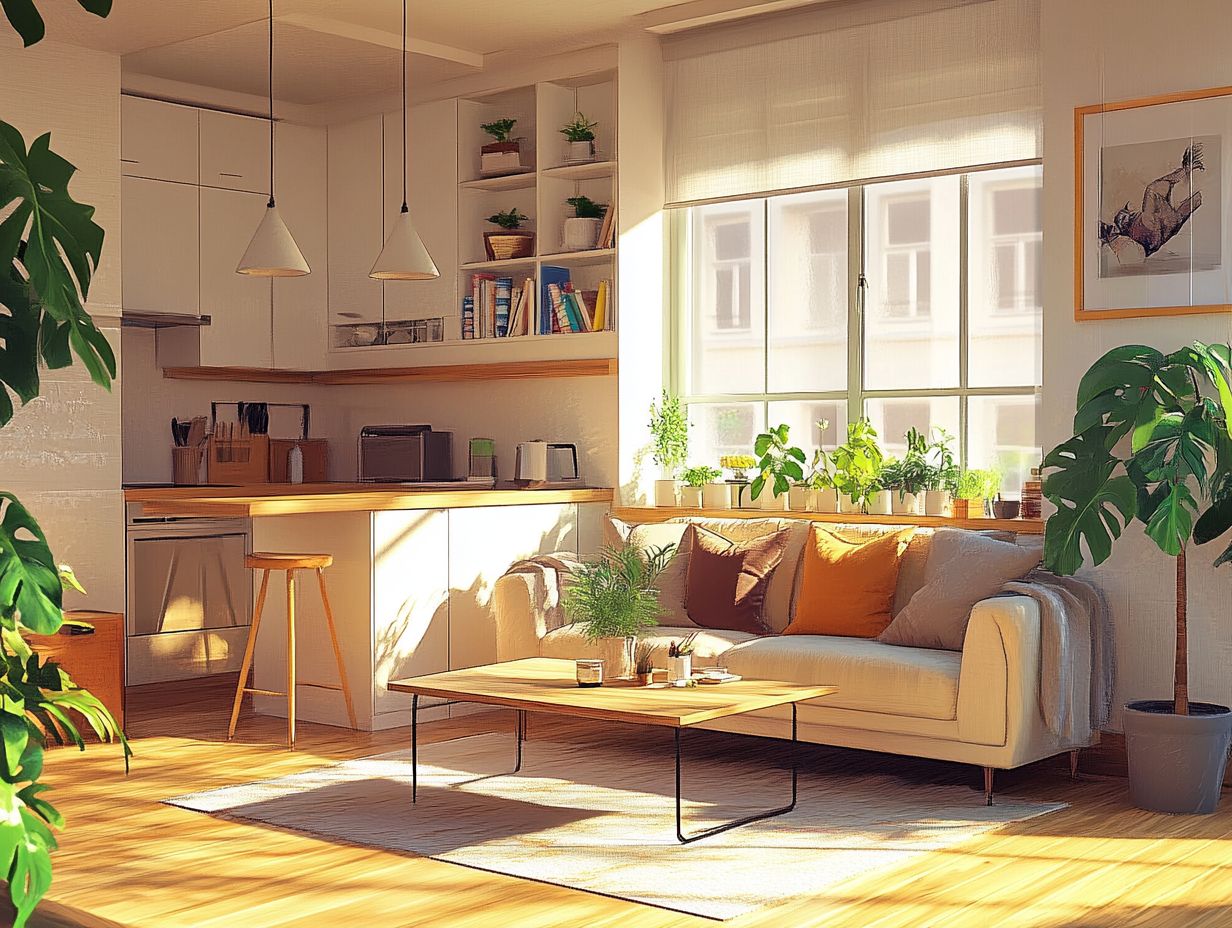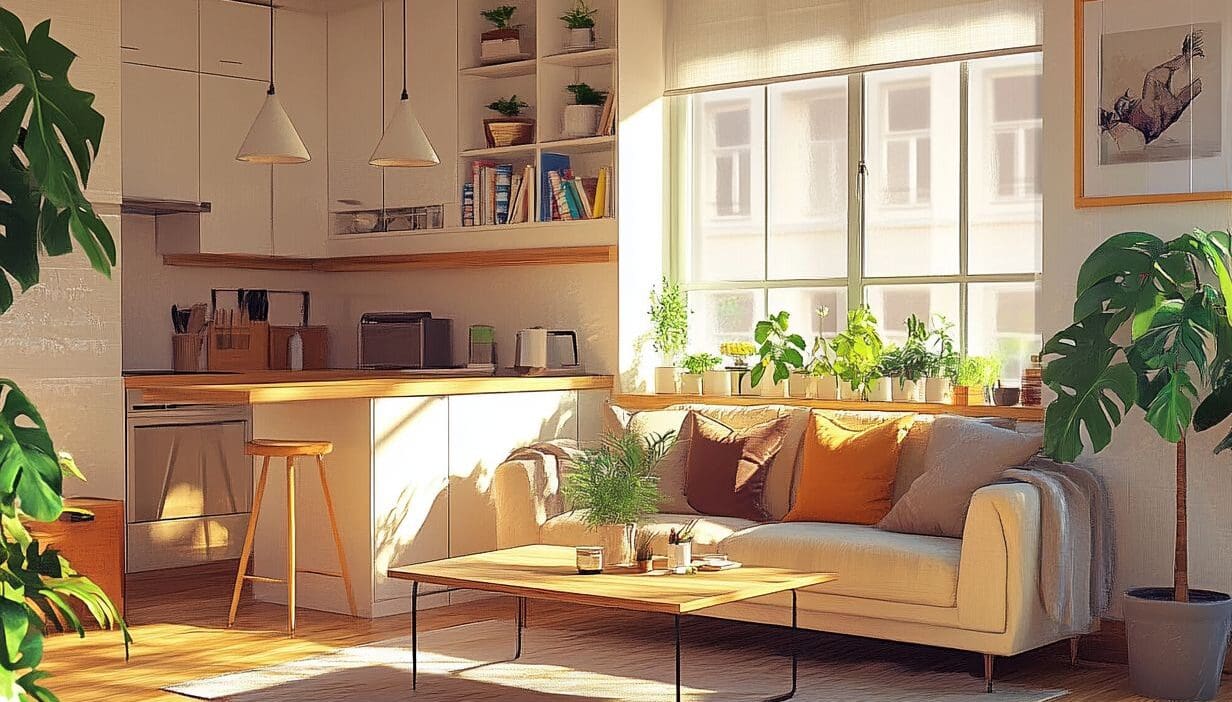Are you seeking to enhance the energy efficiency of your home without compromising on comfort or style? This article provides a comprehensive set of practical tips applicable to every room, from the kitchen to the living room. Discover methods to optimize storage space and organization in your kitchen, implement energy-saving strategies, and create a serene yet productive atmosphere in your bedroom and home office. Additionally, explore effective approaches to declutter your bathroom and arrange your living room layout for maximum comfort. Continue reading to transform your home into a more efficient sanctuary.
Key Takeaways:
Kitchen Efficiency Tips

The kitchen is an essential component of any residence, functioning as a multifunctional area for cooking, socializing, and storage. Optimizing its efficiency can substantially improve the home’s energy performance and overall aesthetics.
By employing strategic design choices and effective interior organization techniques, homeowners can create a functional kitchen that fulfills their family’s needs while reducing clutter and promoting energy-saving practices. For instance, utilizing ENERGY STAR certified appliances can significantly enhance energy efficiency, as noted by ENERGY STAR’s authoritative guidelines.
Utilizing vertical space, incorporating suspended furniture, and making informed decisions regarding appliance energy consumption can transform the kitchen into a paragon of efficiency that aligns with sustainable practices and enhances daily productivity in your creative space.
Maximizing Space and Organization
Maximizing space and organization in the kitchen can significantly enhance its functionality, fostering creativity and efficiency while simultaneously reducing clutter and improving the overall cooking experience.
One effective approach to achieving this is through the thoughtful arrangement of furniture, ensuring that frequently used items are readily accessible while reserving less essential tools for storage.
Utilizing vertical space is another important strategy; the installation of shelves or cabinets that extend to the ceiling can considerably increase storage capacity without compromising floor space.
Additionally, implementing smart storage solutions, such as pull-out drawers, lazy Susans, or wall-mounted racks, can further assist in maintaining order within the kitchen.
Incorporating cleaning appliances, such as a compact dishwasher or a built-in trash bin, not only streamlines the cleaning process but also contributes to an overall organized environment, enhancing the enjoyment of cooking while supporting sustainable practices.
Energy Saving Strategies
Implementing effective energy-saving strategies in the kitchen not only leads to a reduction in energy bills but also contributes to a more sustainable home environment by minimizing the carbon footprint associated with the energy consumption of appliances.
Incorporating ENERGY STAR certified appliances can significantly enhance energy efficiency, as these products utilize less electricity without compromising performance. Additionally, choosing induction stoves offers faster cooking times and improved temperature control, resulting in lower energy consumption compared to traditional gas and electric stoves. According to a recent publication by the U.S. Department of Energy, induction stoves are a smart choice for those looking to improve their kitchen’s energy efficiency.
Utilizing smart power strips can further assist in managing energy usage effectively by disconnecting power from devices that are in standby mode, thereby reducing unnecessary energy draw.
Furthermore, adopting simple practices such as using appropriately sized pots and burners, maintaining appliances, and conducting regular energy audits can also play a crucial role in minimizing energy wastage within the kitchen.
Bathroom Efficiency Tips

A well-designed bathroom can greatly enhance both comfort and utility, while also promoting energy efficiency and sustainable water usage practices. This makes it a crucial area for home improvement, particularly in contemporary households.
By emphasizing effective organizing and decluttering strategies, homeowners can establish a serene and functional environment that balances aesthetics with practicality.
The implementation of water-saving fixtures, such as low-flow showerheads and ENERGY STAR-rated appliances, can result in significant reductions in water and energy consumption, thereby contributing to a more environmentally friendly home. As noted by the US Environmental Protection Agency, adopting these measures can start saving you water and energy right away (embedded citation).
Organizing and Decluttering
Effective organization and decluttering in the bathroom can significantly contribute to a more tranquil environment, enhancing both aesthetics and functionality while fostering a sense of peace and order.
To achieve this, individuals should establish dedicated storage spaces for various items, ensuring that each item has its designated place. The use of baskets, trays, or drawer dividers facilitates easy accessibility and promotes organized space arrangements.
Incorporating natural materials such as bamboo or wicker can further create a calming atmosphere that complements bathroom decor while minimizing visual clutter. By being intentional about the products retained and adopting a minimalist approach, one can transform the bathroom into a serene retreat, ultimately improving the daily routine and encouraging a more mindful use of space.
Water and Energy Conservation
Implementing water and energy conservation practices in the bathroom can result in considerable savings on utility bills while promoting a sustainable lifestyle that benefits both the home and the environment.
By incorporating various conservation techniques, such as the installation of low-flow faucets and showerheads, homeowners can significantly reduce water consumption without compromising performance. Upgrading to ENERGY STAR-rated appliances, including high-efficiency toilets and efficient washing machines, not only decreases water usage but also enhances overall energy efficiency for a more energy-efficient home.
These improvements can lead to a notable reduction in energy bills and a minimized environmental impact, aligning with home energy efficiency goals. When individuals collectively adopt these practices, the cumulative effect can result in substantial positive change, aiding in the preservation of vital resources for future generations while fostering a more eco-friendly household encouraged by home consultations.
Bedroom Efficiency Tips

Transforming a bedroom into a relaxing and productive space is essential for enhancing sleep efficiency and overall well-being. Creating an environment conducive to rest and rejuvenation is critical.
A thoughtfully organized room layout can significantly contribute to a peaceful atmosphere that fosters relaxation and enhances productivity during the day. By optimizing natural light, implementing effective temperature regulation strategies, and minimizing clutter through efficient organization, the bedroom can be transformed into a sanctuary designed for comfort and tranquility.
Creating a Relaxing and Productive Space
Creating a relaxing and productive environment in the bedroom requires careful design choices that emphasize serenity, organization, and functionality.
A well-planned bedroom layout is essential for fostering a sense of calm, facilitating easy navigation, and minimizing stress caused by clutter. The incorporation of natural materials such as wood, cotton, and stone can significantly enhance the overall atmosphere, offering both aesthetic appeal and a connection to nature that promotes tranquility and balance room harmony.
Additionally, the use of soft, muted colors contributes to a soothing color palette, while strategically placed lighting establishes a warm ambiance. Collectively, these elements work in harmony to transform bedrooms into peaceful retreats, enabling individuals to unwind, recharge, and maintain focus on daily tasks.
Ultimately, such a thoughtfully designed environment fosters balance and stability within one’s personal sanctuary, contributing to a minimalist home aesthetic.
Energy Saving Tips for Electronics
Implementing energy-saving strategies for electronics in the bedroom can lead to reduced energy costs and promote a more efficient home environment, in alignment with sustainable practices.
By adopting a few practical energy-saving ideas, individuals can significantly lower their energy footprint. One effective method is to utilize smart power strips that automatically cut off power to devices when they are not in use, thereby preventing phantom energy drain.
Additionally, it is essential to consider the replacement of appliances with energy-efficient models, such as LED bedside lamps and ENERGY STAR-rated devices. These selections not only conserve energy but also enhance overall comfort and functionality within the personal space, fostering a cozy atmosphere while encouraging eco-friendly practices.
Living Room Efficiency Tips

The living room functions as the central hub of the home, serving as a space for family gatherings and relaxation. Optimizing its efficiency through careful furniture arrangement can greatly improve both comfort and functionality.
By concentrating on the strategic furniture layout to encourage flow and interaction, while also maximizing the influx of natural light and applying window treatments, one can cultivate a welcoming environment that promotes connection and relaxation. Furthermore, the implementation of energy-saving strategies, particularly in relation to LED light bulbs for lighting, ensures that the living space remains both inviting and cost-effective.
Furniture Arrangement for Comfort and Functionality in Your Floorplan
Arranging furniture for comfort and functionality in the family room is essential for creating an organized space that facilitates both relaxation and social interaction while maintaining a peaceful room atmosphere.
Effective furniture arrangement involves strategic placement that enhances traffic flow, interior design harmony, and visual appeal. For example, positioning seating around a central coffee table not only fosters conversation but also delineates the social area.
Incorporating multifunctional pieces, such as ottomans with storage capabilities, maximizes utility while maintaining an uncluttered environment. The use of rugs to define areas can establish distinct zones for various family activities, whether hosting a game night, creating a cozy reading nook, or optimizing a shared space.
By thoughtfully considering these elements, homeowners can design a welcoming environment that accommodates daily family life, offering a harmonious blend of style, comfort and productivity, and practicality.
Energy Saving Strategies for Lighting, Electronics, and Home Automation
Implementing energy-saving strategies for lighting, electronics, and home automation in the living room can result in significant cost savings while contributing to the overall energy efficiency of the home.
By selecting LED light bulbs, which consume substantially less energy than traditional incandescent options, individuals can not only reduce their utility bills but also benefit from lighting solutions that have a longer lifespan and are recommended by ENERGY STAR. Additionally, the use of smart power strips, a key component of appliance energy usage management, allows users to manage their electronics more effectively by cutting off power to devices when they are not in use, thereby minimizing energy wastage.
Collectively, these strategies promote a sustainable living environment, leading to reduced energy consumption and a lower carbon footprint, aligning with guidelines from the U.S. Department of Energy. Over time, these decisions can yield considerable savings, positively impacting both financial resources and the environment through appliance replacement and other home energy tips.



